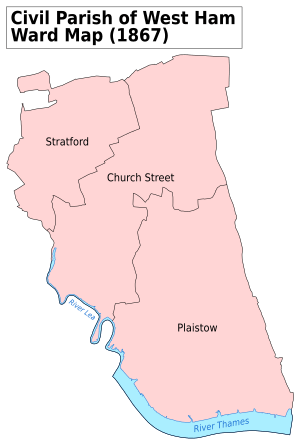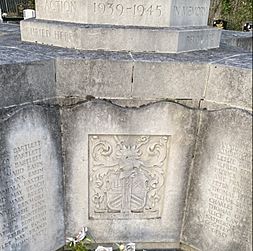County Borough of West Ham facts for kids
| West Ham | |
| Motto: Deo Confidimus (We trust in God) | |
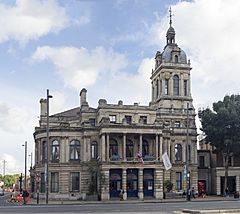 Stratford Town Hall |
|
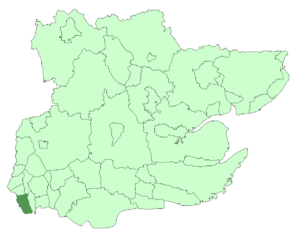 West Ham within Essex in 1961 |
|
| Geography | |
| Status | Civil parish (until 1965) Local board of health district (1856–1886) Municipal borough (1886–1889) County borough (1889–1965) |
| 1861 area | 4,667 acres (18.9 km2) |
| 1911 area | 4,683 acres (19.0 km2) |
| 1931/1961 area | 4,689 acres (19.0 km2) |
| HQ | Town Hall, Broadway, Stratford (1869–1965) |
| History | |
| Origin | West Ham ancient parish |
| Created | 1856 |
| Abolished | 1965 |
| Succeeded by | London Borough of Newham |
Quick facts for kids Demography |
|
|---|---|
| 1861 population - 1861 density |
38,331 8/acre |
| 1911 population - 1911 density |
289,030 62/acre |
| 1931 population - 1931 density |
294,278 63/acre |
| 1961 population - 1961 density |
157,367 34/acre |
| Politics | |
| Governance | West Ham Local Board (1856–1886) West Ham Borough Council (1886–1965) |
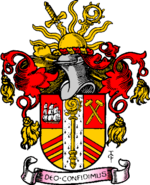 Arms of the county borough corporation |
|
West Ham was an important area in Essex, England, that had its own local government for many years. It was located just north of the River Thames and east of the River Lea, becoming a busy part of London even though it wasn't officially part of the main city until 1965.
Contents
Where Was West Ham?
This area included places you might know today like Plaistow, Stratford, Canning Town, and Silvertown. These are all now part of the London Borough of Newham. In 1901, West Ham was a very large town, with over 267,000 people living there. It was considered part of London's busy area, even though it was technically in Essex.
From 1934 to 1965, West Ham was surrounded by other important areas. To its east was East Ham, to the north were Wanstead and Woodford and Leyton. To the west was Poplar, and to the south was Greenwich.
How West Ham Grew
West Ham grew very quickly starting in 1844. This happened because of a law called the Metropolitan Building Act. This law stopped dangerous factories and smelly industries from operating in the main part of London. So, many of these businesses moved just across the River Lea to West Ham.
Because of this, West Ham became a major center for making things like medicines, chemicals, and processed foods. It grew so fast that people called it "London over the border."
However, many workers lived in very poor conditions, often in crowded slums near their jobs. This led to serious poverty and outbreaks of diseases. It became clear that the local government in West Ham wasn't doing enough to help. There were problems with roads, water, fire safety, and controlling new buildings.
In 1853, some local residents decided to act. This led to an investigation by Alfred Dickens (the brother of the famous writer Charles Dickens). He wrote a report in 1855 that was very critical of the conditions in the slum areas.
Because of this report, a new local group called a "local board of health" was created in 1856. This board had 15 members who worked to improve public health and living conditions.
Becoming a Borough
In 1878, the people of West Ham decided they wanted their town to become a "municipal borough." This would give them more control over their local affairs. One big reason for this was to avoid being swallowed up by a larger London government.
Their first attempt didn't work. But after Croydon became a borough in 1883, West Ham tried again in 1885. This time, they were successful! In July 1886, West Ham was officially granted a "royal charter" and became a municipal borough.
A new local council was formed, made up of a mayor, 12 aldermen, and 36 councillors. They replaced the old board of health. The first elections were held in November 1886. The first mayor was John Meeson. Later, in 1937, Daisy Parsons became the first female mayor.
A County Borough
In 1888, a new law created "county councils" across England and Wales. If a municipal borough had more than 50,000 people, it could become a "county borough." This meant it would have the powers of both a borough and a county council.
West Ham had over 128,000 people in 1881, so it became a county borough on April 1, 1889. This meant West Ham managed its own local government services, separate from Essex County Council. However, it still remained part of Essex for things like justice.
Local Services and Utilities
The West Ham council took over many important services for its residents:
- Trams: In 1898, the borough bought the horse-drawn tram services. They made them electric in 1904 and expanded the network. By 1933, West Ham had 134 tram cars.
- Fire Brigade: The borough also had its own fire brigade, which later joined the London Fire Brigade in 1965.
- Electricity: The council managed the town's electricity supply until 1948, when it became part of a national system.
- Health: After 1929, the council became responsible for some health services, including the large Whipps Cross Hospital. They improved the hospital until it became part of the new National Health Service in 1946.
How the Council Worked
Wards and Councillors
When West Ham first became a borough, it was divided into four areas called "wards": Canning Town, Forest Gate, Plaistow, and Stratford. Each ward elected nine councillors. These councillors served for three years. In addition to the 36 elected councillors, there were also 12 aldermen, who were chosen by the council itself. This made a total of 48 council members.
In 1899, the wards were changed. The borough was divided into 12 wards, with three councillors from each. The total number of councillors stayed at 36.
In 1922, the number of wards increased again to sixteen. Each of these new wards had three councillors and one alderman. This made the council even larger, with 64 members.
Local Politics
West Ham was famous for having the first council in England controlled by the Labour Party. After a big dock workers' strike in London in 1889, many Socialists and Progressives were elected to the council. They officially formed the Labour Group in 1897.
In 1898, the Labour Group won a majority on the council. This was a big deal! To oppose them, a group called the Municipal Alliance was formed. They took control in 1901.
Over the years, control of the council went back and forth between Labour and the Municipal Alliance. However, after the First World War, Labour won a clear majority in 1919 and kept it for the rest of West Ham's existence as a borough. By the 1950s, Labour held almost all the seats on the council.
Coat of Arms
West Ham received its own special coat of arms in 1887.
- The zig-zag lines at the bottom represent Stratford, taken from an old abbey there.
- The crossed hammers at the top right stand for the Thames Ironworks and Shipbuilding Company, which was a major employer in the area.
- The ship represents the Royal Docks and West Ham's long connection to the sea.
- The Latin motto at the bottom, "Deo Confidimus", means "In God We Trust."
Becoming Part of Greater London
For a long time, people wondered why West Ham wasn't part of the main London area, especially since nearby places like Greenwich and Woolwich were. The West Ham Council thought about joining London in 1895 and 1907.
However, they were hesitant. They worried about higher taxes, how London's building rules might affect local industries, and they wanted to keep their independent status as a county borough.
Eventually, a special commission looked at how local government worked in the whole London area. In 1965, the county borough of West Ham, along with East Ham, was officially ended. Their areas, plus small parts of Barking and Woolwich, were combined to create the new London Borough of Newham within Greater London.


